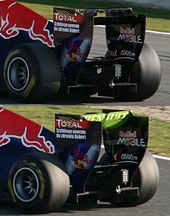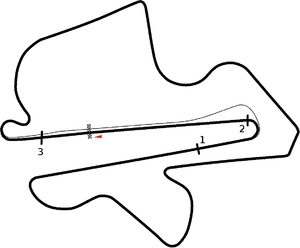- Drag reduction system
-
Driver adjustable bodywork,[1] commonly known as drag reduction system (or DRS), is a motorsport technology aimed at reducing aerodynamic drag in order to promote overtaking in Formula One. DRS was introduced in the 2011 Formula One season and is an adjustable flap on the rear wing of the car, which opens and closes in correspondence with a driver's commands.
The device opens an adjustable flap on the rear wing of the car (which when closed creates more downforce for greater cornering) to reduce downforce, thus giving a pursuing car more speed and a greater chance of overtaking a car in front.
DRS comes with conditions, such as the pursuing car must be within a second (when both cars cross the detection point) for DRS to be activated. Also, the device can only be used, during a Formula One motor race once two racing laps have been completed, and when the pursuing car enters a designated 'activation' zone defined by the FIA.
In 2011, the FIA increased the number of DRS zones to two on some circuits featuring multiple long straights. In Valencia and in Montreal, two zones were endorsed on consecutive long straights, whilst in Monza and in Buddh, two zones were created on separate parts of the circuit. Two zones had originally been planned for every race with multiple long straights from Montreal onwards (depending on Montreal/Valencia success) - but such plans did not materialize.[2] However, at the penultamite round of the 2011 season, two zones on consecutive long straights saw a return - at Yas Marina.
Contents
Functional description
The horizontal elements of the rear wing consist of the main plane and the flap. The DRS allows the flap to lift a maximum of 50 mm from the fixed main plane. This reduces opposition (drag) to airflow against the wing and results in less downforce. In the absence of significant lateral forces (straight line), less downforce allows faster acceleration and potential top speed, unless limited by the top gear ratio and engine rev limiter. Sam Michael, technical director of the Williams team, believes that DRS in qualifying will be worth about half a second per lap.
The DRS is expected to offer 10–12 km/h more speed by the end of the activation zone.[3] The effectiveness of the DRS will vary from track to track and to a lesser extent from car to car. The system's effectiveness will be under review throughout 2011 to see if overtaking can be made easier, but not to the extent that driver skill is sidelined. The effectiveness of DRS seems likely to be determined by the level of downforce at a given circuit (where the cars are in low drag trim at circuits like Monza, the effects may be smaller), by the length of the activation zone and by the characteristics of the track immediately after the DRS zone.
Rules on use
The usage of DRS is limited by the F1 rules. It is allowed to be used only when:
- The following car is a maximum of one second behind the leading car (the FIA reserves the right to alter this parameter, race by race).
- The following car is in an overtaking zone as defined by the FIA before the race (commonly known as the DRS Zone).
Further:
- The system may not be activated on the first two laps of a race.
- The system cannot be used until two laps have passed after a restart or safety car appearance.
- The system may not be enabled if racing conditions are deemed dangerous by the race director, such as rain as was the case at the 2011 Canadian Grand Prix.
The drivers are able to use the system without restriction during practice and qualifying. A dashboard light notifies the driver when the system is enabled. The system is deactivated when the driver releases the button or brakes.
There are lines on the track to show the area where the one-second proximity is being detected and a line later on the track where the drivers whose system is deemed valid to be armed may deploy it. These lines are more commonly referred to as the 'detection point' and the 'activation point'.
Reception
There has been a mixed to positive reaction to the introduction of DRS in Formula One amongst both fans and drivers. Some believe that this is the solution to the lack of overtaking in F1 in recent years while other believe this has made overtaking too easy.[4] The principal argument for the opponents of DRS is that the driver in front does not have an equal chance of defending his position because they are not allowed to deploy DRS to defend. The tightening up on the rules for a leading driver defending his position has added to this controversy.[5]
See also
- Kinetic Energy Recovery Systems (Commonly known as "KERS")
References
- ^ "2011 F1 Technical Regulations, Section 3.18"
- ^ [http://adamcooperf1.com/2011/05/20/two-race-drs-zones-from-montreal-onwards/
- ^ www.ozracingwrap.com/news/formula-1/2537-the-f1-movable-rear-wing-drag-reduction-system-explained.html
- ^ "Is DRS Making overtaking too easy? - Martin Brundle"
- ^ "F1 2011 Sporting Regulations"
Categories:
Wikimedia Foundation. 2010.


